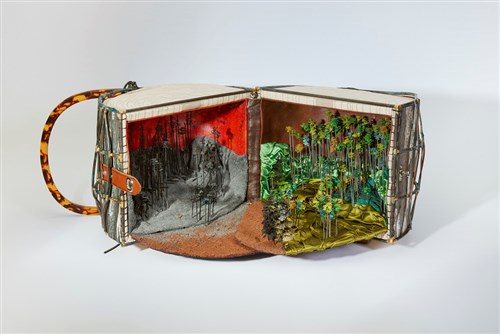The sculptural and instructional valises will be used by the National Park Service and County Fire Department to teach about fire prevention, national forests, and our relationship to nature. Each valise has a theme with specific talking points, and all of them circle back toward teaching issues about fire abatement and our connection to wilderness. The female inmates at Camp 13 who have been trained as firefighters supplied the content for the valises through their experiences with firefighting and fire abatement methods. The process was organic in the sense that there was a two-way conversation between Abeles as artist-in-residence and the inmates regarding the development of the valises. The women supplied the content based on their experiences, and also responded to the artistic and content-driven outcomes. Participants worked alongside as well as with the artist on the elements of the valises. Some of the valises respond to discussions with park rangers regarding issues including fire prevention in residential areas especially those adjacent to forests; securing homes from wildlife entering and getting trapped, and conversely, encouraging wildlife through habitats; invasive plants vs native species; and citizen’s responsible use of parks and national forests. Armory Center for the Arts in Pasadena held an exhibition that featured ten small, mixed media travel suitcases (known as "valises") created during a long-term collaboration between artist Kim Abeles and the female inmates of Camp 13—a correctional facility in the Santa Monica Mountains for women who are trained and deployed to fight forest fires throughout the region. The valises will be used as educational tools at public events by the National Park Service and Los Angeles County Fire Department to teach the public about fire prevention, national forests, and our relationship to nature. This project was managed by Armory Center for the Arts and was made possible with support from the National Endowment for the Arts and the Los Angeles County Arts Commission. Valise 1 - Fire Line is specific to firefighting. The exterior is adorned with the first names of the women Abeles worked with at Camp 13. Details include;
• firebreak (cutting 15-20 feet wide for fire prevention), and fire lines (4-feet wide) or cut lines between the burnt and live landscape
• photograph of a conifer is surrounded by a welded cage-like structure
• names of all the women at CAMP 13 who participated and written as rings of the tree
• encourages discussion of fire abatement, fire hazard reduction tips, and about the paid and inmate workforces who clear the area and fight our fires
Kim Abeles is an artist whose community-based projects explore biography, geography and environment. She has created projects with the California Science Center, air pollution control agencies, health clinics and mental health departments, and natural history museums in California, Colorado and Florida. In 1987, she innovated a method to create images from the smog in the air, and Smog Collectors brought her work to national and international attention. Permanent outdoor works include Walk a Mile in My Shoes, based on the shoes of the Civil Rights marchers and local activists. Abeles has received fellowships from the Guggenheim Memorial Foundation, J. Paul Getty Trust Fund, and her process documents are archived at the Center for Art + Environment. Her work is in public collections including MOCA, LACMA, CAAM, Berkeley Art Museum, and National Geospatial Intelligence Agency. Recent publications about her projects include New York Times, Los Angeles Times, American Scientist Magazine, and the forthcoming book, Social Practice: Technologies for Change, Routledge Press. To learn more, please visit: About - Kim Abeles.



